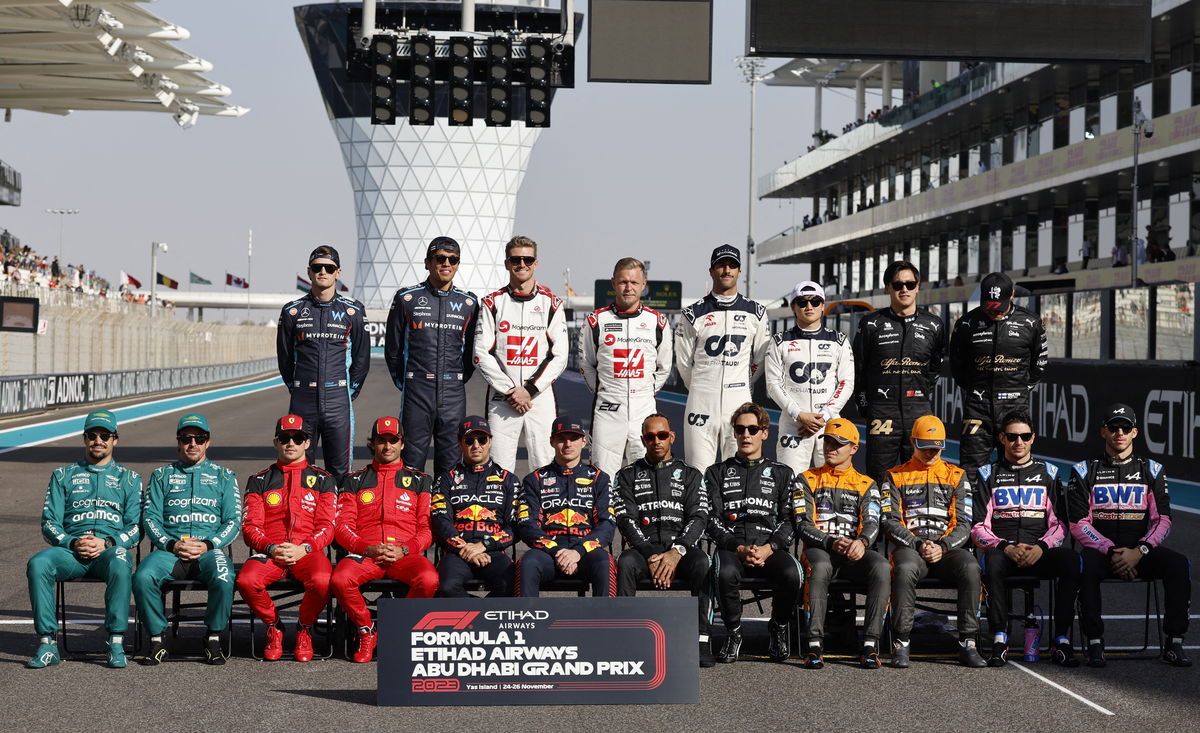
Reuters
Formula One F1 – Abu Dhabi Grand Prix – Yas Marina Circuit, Abu Dhabi, United Arab Emirates – November 26, 2023 The drivers pose for a group photo before the race REUTERS/Hamad I Mohammed

Reuters
Formula One F1 – Abu Dhabi Grand Prix – Yas Marina Circuit, Abu Dhabi, United Arab Emirates – November 26, 2023 The drivers pose for a group photo before the race REUTERS/Hamad I Mohammed
Formula 1’s goal for a sustainable future is pretty well-known at this point. F1 has a mission in place for racing to be carbon-neutral by the end of 2030. However, according to several stakeholders within and around the world of F1, strongly believe that despite public statements, F1 is moving in the opposite direction.
Watch What’s Trending Now!
Yes, they may be looking into sustainable fuel, yes they are increasing the use of electricity instead of burning fossil fuels, and yes, other measures like tire warmers are being looked at closely to monitor the impact that they have. But it may not be necessarily enough, as a significant carbon footprint is generated in other places altogether.
ADVERTISEMENT
Formula 1’s ‘hypocrisy’ called out:
The logistics side of things generates the vast majority of the carbon footprint. Shipping the cars to different countries during different weekends, flying the whole paddock in, the drivers, mechanics, engineers, and catering staff, among other things, contribute to a major portion of the carbon footprint generated.
ADVERTISEMENT
Speaking about this to former Ferrari boss Peter Windsor, F1 photographer Darren Heath calls out the hypocrisy of Formula 1. “ (My biggest problem) really is the hypocrisy. I have a problem with sports such as Formula One, which obviously burns a lot of carbon. They’re trying to do certain things to lower the levels of carbon footprint, which I’m all onside with.”
ADVERTISEMENT
However, this is not enough, and this is not where the majority of the carbon footprint is coming from. “But when the teams and their cohorts of the great armada of people that flights all round the world, the trucks, the catering staff, the mechanics the team engineers, the team bosses, not to mention the drivers, and the press of course. When we all fly around the world, there’s more carbon footprint,” Heath comments.
Top Stories
Who Is Oscar Piastri’s Father, Chris Piastri? Co-Founder of Multibillion Dollar Automotive Company

Who Is Flavy Barla? – Esteban Ocon’s New Girlfriend After His Breakup With Elena Berri

Who Is Charles Leclerc’s Mother, Pascale Leclerc?

Who Are Yuki Tsunoda’s Parents? Everything You Need to Know About Minako and Nobuaki Tsunoda

Max Verstappen’s Siblings: Everything We Know About Victoria, Blue Jaye, Jason Jaxx, and Mila Faye

Read more: ‘F1 Is Not a Sustainable Sport’-Massive Claims by Formula E Chief
In most people’s opinions, this is more damaging than those largely fuel-inefficient cars burning fuel on race weekends. And, to further complicate things, the sport is starting to expand massively as well to new countries, adding more and more races to the race calendar.
ADVERTISEMENT
F1’s calendar is part of the problem
There has been a massive increase in the number of races over the last decade. F1 has expanded out to the middle east, and starting to grow in popularity in the Americas as well. As a result, we are now seeing 22-24 race season, instead of the 16-18 from the yesteryears. Naturally, this will lead to more carbon footprint being generated as a result of not only the travel but also the fuel that’s burnt during the race weekends as well.

Reuters
Formula One F1 – Abu Dhabi Grand Prix – Yas Marina Circuit, Abu Dhabi, United Arab Emirates – November 26, 2023 McLaren’s Oscar Piastri in action during the race REUTERS/Rula Rouhana
Heath continues, “This year, we had 22 races. next year 24 races are scheduled. I think the calendar is way way too many (races). I think the sweet spot for me is around 18. I think that’s a pretty good number of races.” Heath clarifies that he thinks races in the Far East and the Middle East are a good idea, and thinks that the races should be less “European-centric.”
ADVERTISEMENT
Apart from the carbon footprint, Heath opines that there’s the factor of burnout involved as well when we are witnessing a 24-race calendar. “24 races – there’s real burnout within the sport.”
Watch This Story – Accusations By Nyck de Vries Against Red Bull For Robbing Lewis Hamilton Are Debunked as “Fake,” With Alarming Details Disclosed By De Vries’ Confidant
ADVERTISEMENT
Despite this criticism, the number of people within the sport, like Lewis Hamilton and Sebastian Vettel, who constantly push the sport to do better is increasing. Hopefully going forward, we see F1 reduce its carbon footprint.
ADVERTISEMENT
ADVERTISEMENT
ADVERTISEMENT

